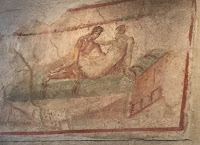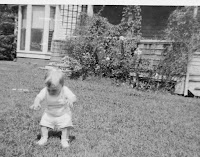Fast Train to Ostia Antica
Diario di Roma II: Rome Diary 2
Sunny and Pleasant 86°F/30°C in Roma
Buongiorno,
 |
| The OTHER Mike Botula! |
As our tour group was forming up in front of
the Metro station at Piramidé, I found myself musing Gee,
Mikey! You’ve been here almost a month, now. Beginning to feel almost a native
are you? And, just as that “thought balloon” was forming, the nice lady
from Atlanta turned to me and said, Pahdon
me, suh! But, do y’all speak English? Now, I could have been a total
wise-ass, and replied, Non parlo
l’Inglese! And I have done that in Spanish, French, German and Italian.
But, this lady was well mannered, and had inquired in that warm Southern drawl
that had Georgia peach written all over it. Yes,
ma’am. I do speak English. Can I help you? I had remembered, too, that my
son, Michael, was our guide for this trip to the ancient Roman seaport of Ostia
Antica. So, even by association, I also represented City Wonders Tours. My word! You not only speak English, but you
speak it beautifully! Ah can’t detect a smidgen of any accent. Wheah are y’all
from? The lady from Atlanta had just made my day. She had mistaken me for
an Italian. California, ma’am! Southern
California to be exact.
| 40 Minutes from The Coliseum! |
I’ll get to today’s ancient ruins in just a
moment. But, first, I want to take note of the fact that Ancient Roma, founded on April 21st 753 BC by Romulus and Remus, is one of the world’s top
attractions for American tourists. Chances are, when you come to Rome, you will
run into someone who lives right down the street from you. Or is from the same
home town. Or knows someone you used to work with. So, if you really want to
get away from home and those pesky relatives or neighbors, book a flight to
Baluchistan!
| Ostia's "Forest Lawn" |
A short walk from the Ostia Antica train stop
brings you to the ancient city’s necropolis,
just outside the main gate. Here is where some Californian no doubt got the
bright idea for Forest Lawn. It is Ostia Antica’s City of the Dead, the cemetery, which by Roman law is located
outside the city so the living can avoid the odors, and the smoke from funeral
pyres, and also avoid the shadow people or
ghosts that haunt every cemetery. Michael has loaned all of us a small wireless
receiver and headset, so we can better hear his commentary and still wander away
from our intrepid guide to better explore the city. It is a fascinating place,
and my son has told me a number of times that it’s one of his favorite tours.
Now, it’s also become one of mine, too.
In a total role reversal, these tours of the
Italian countryside, have become for Michael and I, a sort of Take Your Father to Work Day! When he was little, I’d wait until the news
director was out of town, and as a special treat take him or his sister Dana
with me as I combed Los Angeles for top stories as a field reporter for KTLA.
That way Mike and Dana could rush home at the end of my shift and call their
friends so they could tell them first what stories would be on Hal Fishman’s
Ten O’clock News. Now, that my little boy is all growed up and working in one
of the most fascinating cities in the world, I’m more than content to tag along
and go to work with him. As his dad,
it’s a treat for me to watch him in action. And, I have no compunctions about
plugging his company, City Wonders!
So, with a gentle lurch as our train pulled
out and Mike’s standard comment that it had left on time, thanks to Benito
Mussolini, we head out of Rome bound for the ancient port of Ostia Antica. On
the way Michael regaled his audience with his own spiel about the history of
the city we would soon be walking through. The wireless headsets give his
comments the sound and feel of a personal conversation in a “back home”
American accent– one to one – with your personal tour guide.
 |
| Lasagna Topping - Jupiter's Temple |
In Rome, one is surrounded by history. And,
in these parts, history runs deep. Michael likes to tell his audiences that
Rome is a historical lasagna- layer
upon layer of history. Where modern day Americans simply replace every building
more than twenty years old. (Or so it seems). The ancients simply built on top
of whatever was there. It’s not uncommon in these parts to find buildings that
have been continuously occupied for a thousand years or more. A walk along just
about any street in Rome will put you twenty or thirty feet above the street
level in Julius Caesar’s time. In Ostia Antica, for example, a walk along the
main street is like a trip nowadays to the Mall of America. There are
restaurants, and markets, granaries and bakeries with goods brought in from the
length and breadth of the Roman Empire, all flowing through the bustling port
city we are visiting today. For entertainment, there are amphitheaters whose
acoustics are still so excellent that a song or dramatic line done on stage in
a whisper can be heard far away in the nosebleed seats. At one end of the
forum, the Temple of Jupiter reaches into the sky behind a massive altar.
Jupiter is the Roman name for the Greek God Zeus. The ancient Romans, it seems,
were not above a little repackaging on a lot of fronts.
 |
| MikeBo Meets a Native! Valentina |
As we began our walk through the Necropolis, the city’s cemetery, I
noticed an attractive young woman with a professional grade Nikon camera taking
more than tourist caliber snapshots. I had spent too long as a newsman, and
later as a press secretary, not to recognize another pro in the field. This gal
was good. Her focus was on our guide, and the smiling tourists who were
obviously enjoying themselves in these ancient surroundings. (Oh! And, did I
mention that she was gorgeous?) A little while later, as we walked to the next
point of interest, I asked Michael if he had a company photographer along for
some publicity shots or if he had a travel writer in his group, ghost writing
for Rick Steves. Nothing like that, Pop!
Her name is Valentina. She’s one of my students! She’s not a travel writer. She
just likes to take pictures. I was
incredulous. And, what, pray tell can a
fellow like you, teach someone like her? He smiled. English, Dad! Remember what I told you about my other job – teaching
English to Italian business people at multinational corporations? Well,
Valentina works for one of my clients. With that, Michael introduced us.
Fortunately for me, Michael has done a better job of teaching Valentina English
than I have done learning Italian. She had come along on the tour to practice
her photography and to see how Michael handles a multilingual tour group which
helps fulfill her language credit. And, in my conversation with the two of
them, a plan began to form in my feeble mind – I will find a way to move to Rome,
and get better acquainted with my new surroundings and start a new career at
the same time by exchanging English lessons for Italian lessons.
Rick Steves.
Ciao,
MikeBo
PS: Since you are kind enough to follow my exploits on Facebook or my
blog – mikebotula.blogspot.com – it’s only fair to tell you that my Rome Diary
is also featured on my personal website – www.mikebotula.com!
As we say in Roma Antica, A più tardi! See
you later!
©Mike
Botula 2015




















